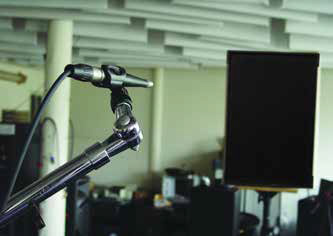
Tale Of Two Loudspeakers
Everything we’ve covered so far about the 6 dB level drop for each doubling of distance assumes a point-source loudspeaker.
That is, a single loudspeaker on a pole with a bass driver and a horn. The sound energy from this loudspeaker will spread out spherically in a pattern dependent on the geometry of the horn (i.e., a common pattern is 60 by 90 degrees).
This is called the inverse-square law, which not only dictates about how sound levels drop off in a big room or outside but also describes how light energy is reduced depending on how far each planet is from the sun.

Is there a way to “beat” the inverse-square law so there’s not as much difference in SPL from the front to the back of the room? You bet, but only up to a point. Enter line arrays.
Generally speaking, line arrays come in two flavors – single columns and fully modular arrays. Both work on the same principal of a tall column of loudspeaker drivers stacked closely together in a line. Instead of all the sound emanating from a single “point source,” the sound source is spread out in a “line.”
This tends to narrow the vertical dispersion, while the small-diameter drivers (in a column cabinet) or horn geometry (in a modular system) widen the horizontal sound pattern to perhaps 110 degrees or more.
In addition, if a line array is sufficiently long, the SPL drop-off in the nearfield can be much less, approaching a theoretical 3 dB level drop for each doubling of distance out to perhaps 50 to 60 feet back for an average-size/scale line array in a room. But get back far enough from any line array and it begins to act like a point-source loudspeaker, with a normal 6 dB drop per doubling of distance. This is often described as a “cylindrical wave,” but that’s a marketing concept, not a scientific one.

The real explanation is that a line of acoustic sources is decoherent or partially coherent in the nearfield due to the staggered arrival times and increases in coherency as we move away from the array. Once the arrivals from all the drivers have converged, we’re back to the regular 6 dB/distance double just like any other sound source.
Closing Thoughts
Armed with these basics, the next time the “noise police” stick an SPL meter directly in front of your system’s loudspeakers and proclaims that you’re in violation, be sure to ask what distance from the stage they’re supposed to be measuring from as well as if they’re using an A- or C-weighted scale, as well as confirming that they’re using the specified slow integration time.
Finally, know that due to manufacturing tolerances, every smartphone is a little bit different, so the SPL meter needs to be calibrated before it’s usable. I’ve measured more than a 10 dB difference between different Android phones prior to calibration, so don’t stake you SPL measurements on a free app.
It’s better to acquire a dedicated SPL meter and use it to gather measurements, especially if they’re needed for noise ordinances. Galaxy Audio makes affordable meters that are factory calibrated and work well for live gigs.
Of course, programs like 10EaZy SPL monitoring and logging software (distributed in the U.S. by Rational Acoustics) combined with a quality calibration microphone can deliver very accurate measurements, but that’s beyond the scope of this discussion.
